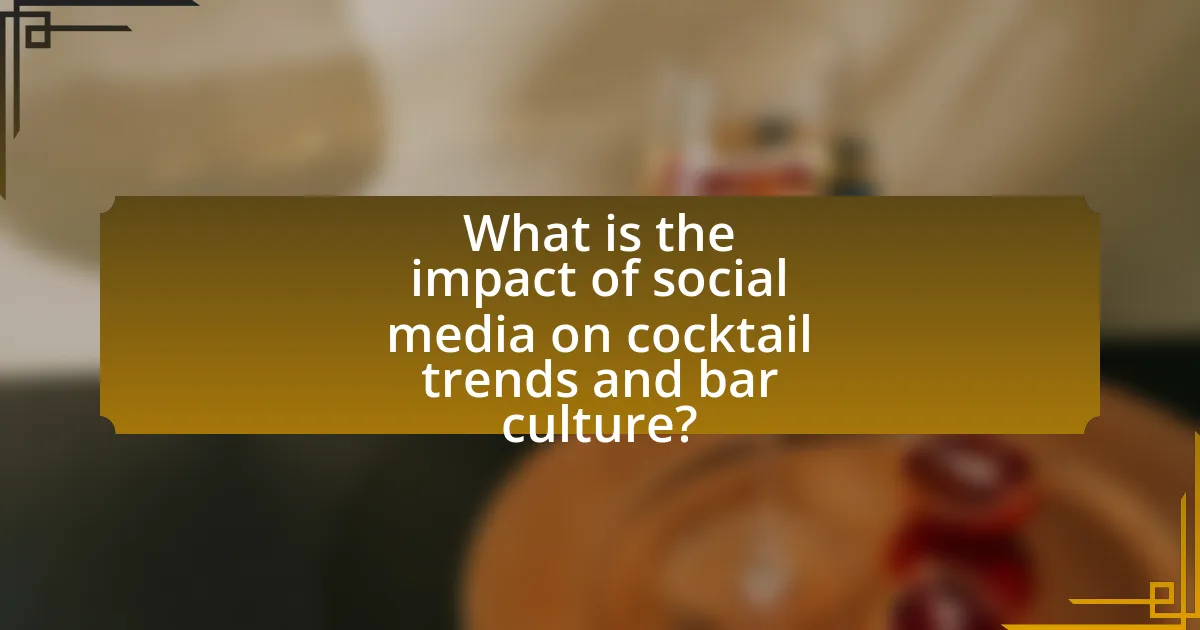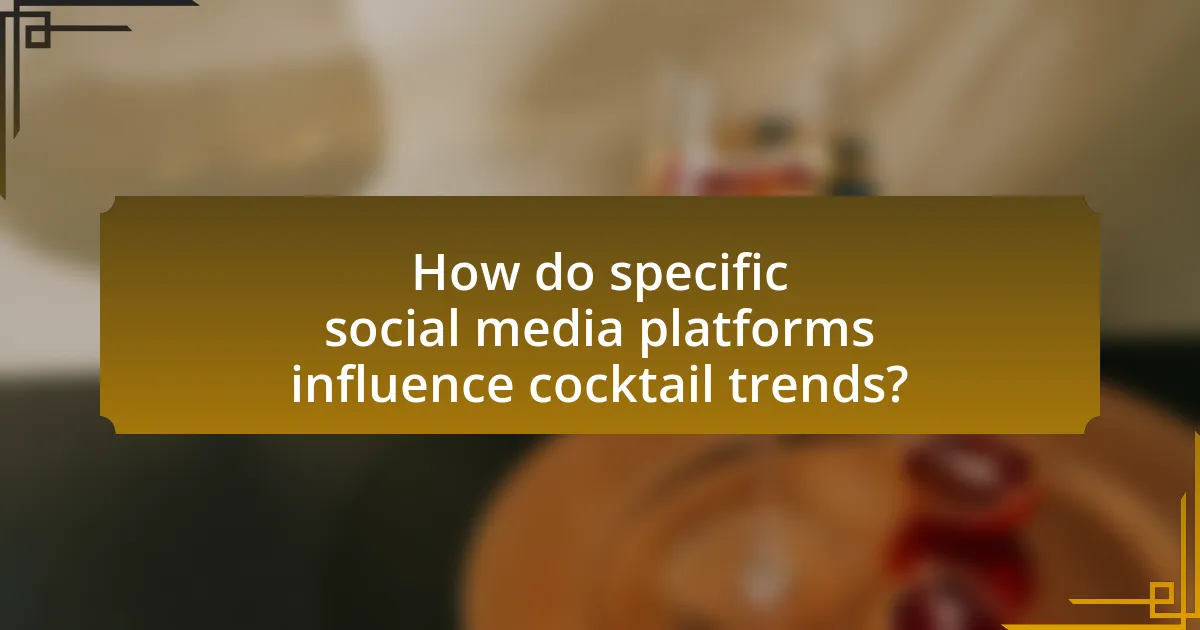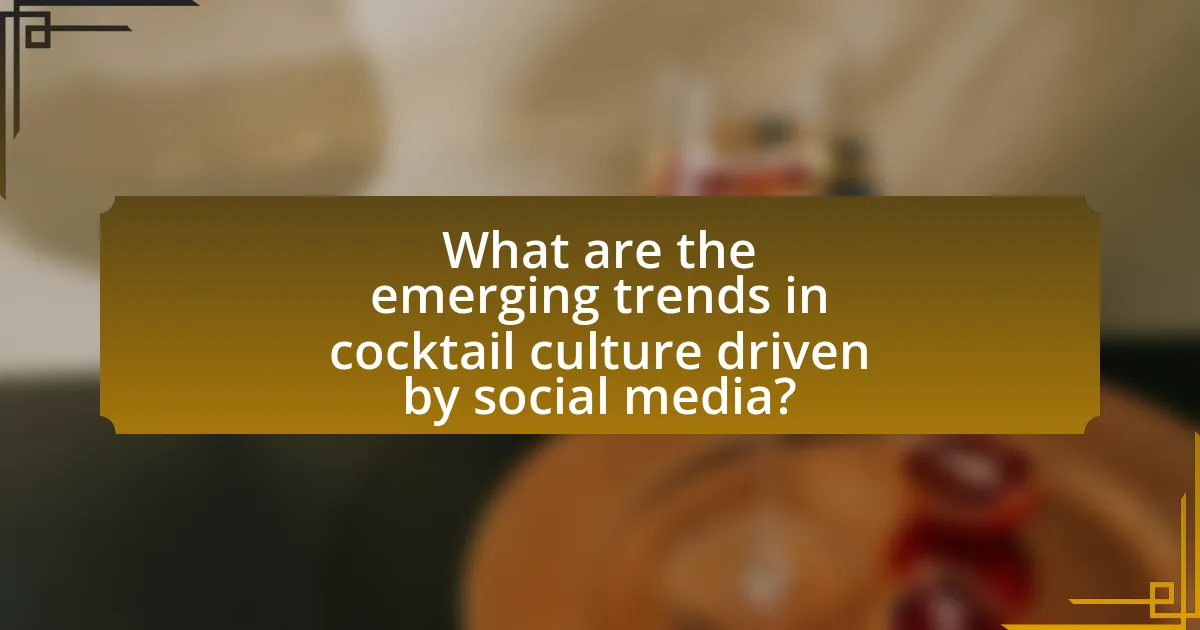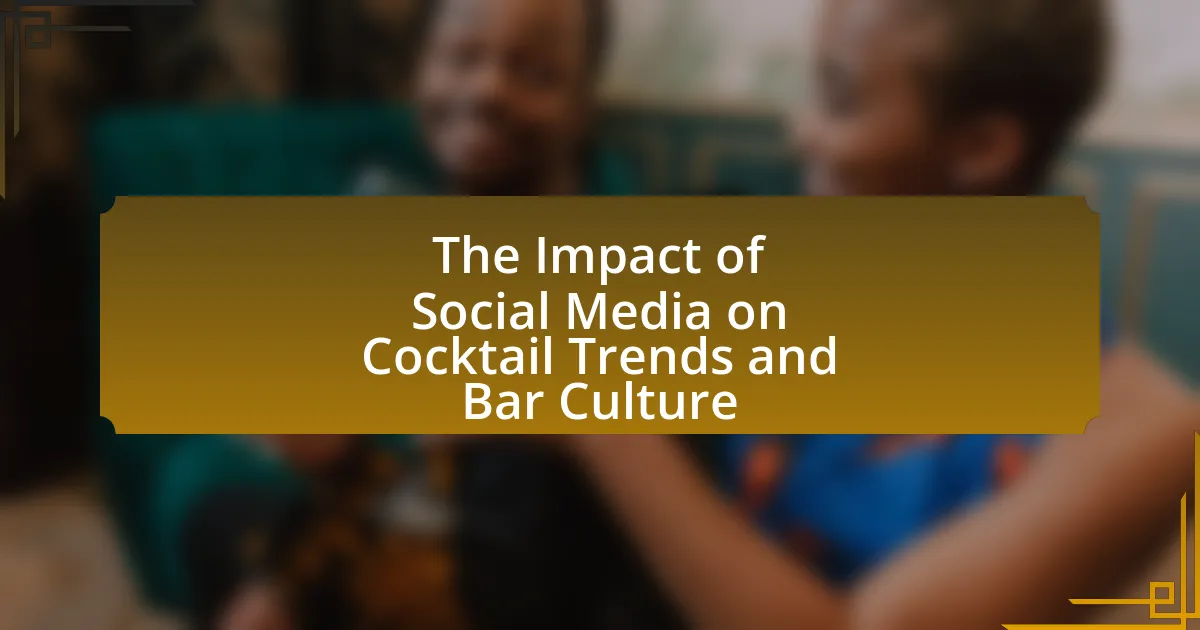The article examines the significant impact of social media on cocktail trends and bar culture, highlighting how platforms like Instagram and TikTok facilitate the rapid spread of new drink recipes and trends. It discusses the transformation of cocktail perception, the role of influencers in shaping trends, and how social media enhances cocktail discovery and brand loyalty. Additionally, the article addresses the challenges bars face due to social media scrutiny, the emergence of sustainability in cocktail practices, and the evolving trends in mixology driven by online exposure. Key strategies for bars to leverage social media for promotion and engagement are also outlined.

What is the impact of social media on cocktail trends and bar culture?
Social media significantly influences cocktail trends and bar culture by facilitating the rapid dissemination of new drink recipes and trends. Platforms like Instagram and TikTok allow bartenders and enthusiasts to showcase visually appealing cocktails, leading to viral trends that can quickly change consumer preferences. For instance, the rise of craft cocktails and unique ingredients has been propelled by social media exposure, with hashtags like #CocktailOfTheDay generating millions of posts. Additionally, social media enables bars to engage directly with customers, fostering a community around cocktail culture and encouraging patrons to share their experiences, which further amplifies trends. This dynamic interaction has transformed traditional marketing strategies in the bar industry, making social media a crucial element in shaping contemporary cocktail culture.
How has social media changed the way cocktails are perceived?
Social media has significantly transformed the perception of cocktails by enhancing their visibility and desirability. Platforms like Instagram and TikTok allow users to share visually appealing images and videos of cocktails, which influences consumer preferences and trends. For instance, a study by the Journal of Consumer Research found that visually attractive food and drink posts can increase consumer interest and willingness to try new items. This visual culture has led to a rise in the popularity of craft cocktails, as bartenders and brands showcase unique ingredients and elaborate presentations, making cocktails not just beverages but also social status symbols.
What role do influencers play in shaping cocktail trends?
Influencers play a significant role in shaping cocktail trends by leveraging their social media platforms to showcase new recipes, brands, and drinking experiences. Their ability to reach large audiences allows them to introduce innovative cocktails and promote specific ingredients or styles, often leading to viral trends. For instance, the rise of visually appealing cocktails, such as those featuring vibrant colors or unique garnishes, can be traced back to influencer posts that emphasize aesthetics, driving consumer interest and demand. Additionally, influencers often collaborate with brands, providing authenticity and credibility that can influence consumer choices, as seen in campaigns where influencers highlight craft spirits or artisanal mixers. This dynamic interaction between influencers and their followers creates a feedback loop that continuously shapes and evolves cocktail culture.
How do social media platforms facilitate cocktail discovery?
Social media platforms facilitate cocktail discovery by enabling users to share and discover cocktail recipes, trends, and experiences through visual content and community engagement. Platforms like Instagram and TikTok allow users to post images and videos of cocktails, often accompanied by hashtags that categorize content, making it easily searchable. According to a study by the National Restaurant Association, 30% of consumers reported discovering new cocktails through social media, highlighting its role in influencing drink choices. Additionally, user-generated content fosters a sense of community, encouraging interaction and sharing among cocktail enthusiasts, which further amplifies the visibility of new cocktail trends.
Why is social media important for bars and cocktail brands?
Social media is important for bars and cocktail brands because it enhances brand visibility and customer engagement. By utilizing platforms like Instagram and Facebook, bars can showcase their unique cocktails, promote events, and interact with customers in real-time. According to a study by the National Restaurant Association, 70% of consumers are influenced by social media when deciding where to eat or drink, highlighting its role in driving foot traffic and sales. Additionally, social media allows bars to tap into user-generated content, where customers share their experiences, further amplifying brand reach and authenticity.
What advantages do bars gain from a strong social media presence?
Bars gain increased visibility and customer engagement from a strong social media presence. This visibility allows bars to reach a broader audience, attracting new patrons through targeted advertising and organic reach. For instance, a study by Sprout Social found that 79% of consumers are more likely to engage with brands that have a strong social media presence. Additionally, social media platforms enable bars to showcase their unique offerings, such as signature cocktails and events, fostering a sense of community and loyalty among customers. This engagement can lead to higher foot traffic and increased sales, as bars can directly communicate promotions and events to their followers.
How does social media contribute to brand loyalty in the cocktail industry?
Social media contributes to brand loyalty in the cocktail industry by fostering direct engagement between brands and consumers, enhancing brand visibility, and creating a community around cocktail culture. Brands that actively engage with their audience on platforms like Instagram and Facebook can build a loyal following by sharing visually appealing content, responding to customer inquiries, and promoting user-generated content. For instance, a study by Sprout Social found that 70% of consumers feel more connected to brands with a strong social media presence, which directly correlates with increased brand loyalty. Additionally, social media allows brands to showcase their unique offerings and cocktail recipes, encouraging consumers to try and share their experiences, further solidifying loyalty.
What are the negative effects of social media on cocktail culture?
Social media negatively affects cocktail culture by promoting superficiality and encouraging trends over craftsmanship. The emphasis on visually appealing drinks for social media sharing often leads to a focus on aesthetics rather than quality ingredients and traditional techniques. This shift can dilute the appreciation for the art of mixology, as bartenders may prioritize Instagrammable presentations over flavor and balance. Additionally, the rapid spread of viral cocktail trends can result in a lack of originality, as bars feel pressured to conform to fleeting fads rather than develop their unique offerings. This phenomenon can undermine the diversity and richness of cocktail culture, as the emphasis on trends may overshadow the historical and cultural significance of classic cocktails.
How can misinformation spread through social media affect cocktail trends?
Misinformation spread through social media can significantly alter cocktail trends by promoting false recipes, ingredients, or health benefits associated with certain drinks. For instance, viral posts claiming that a specific cocktail has detoxifying properties can lead to a surge in its popularity, despite lacking scientific backing. A study by the Pew Research Center found that 64% of Americans believe misinformation has caused confusion about health-related topics, which can extend to food and beverage choices. This confusion can result in consumers gravitating towards trendy cocktails based on misleading information, ultimately shaping market demand and influencing bartenders’ offerings.
What challenges do bars face due to social media scrutiny?
Bars face significant challenges due to social media scrutiny, primarily including reputational damage and increased customer expectations. Negative reviews or posts can quickly spread, leading to a decline in patronage; for instance, a single viral complaint can result in a noticeable drop in foot traffic, as evidenced by a study from the Journal of Hospitality and Tourism Research, which found that 70% of consumers trust online reviews as much as personal recommendations. Additionally, social media amplifies customer expectations regarding service quality and ambiance, compelling bars to constantly innovate and maintain high standards to avoid backlash. This pressure can strain resources and lead to operational challenges, as bars must balance quality with profitability in a competitive landscape.

How do specific social media platforms influence cocktail trends?
Specific social media platforms significantly influence cocktail trends by shaping consumer preferences and promoting new drink recipes. Instagram, for instance, serves as a visual platform where aesthetically pleasing cocktail images can go viral, leading to increased popularity of specific drinks, such as the “Aperol Spritz,” which gained traction through visually appealing posts and hashtags. TikTok further amplifies this effect by allowing users to share quick, engaging videos that demonstrate cocktail-making techniques, often resulting in trends like the “Whipped Coffee” cocktail. Research indicates that 79% of users on these platforms discover new food and drink trends through social media, highlighting the direct correlation between social media engagement and cocktail popularity.
What unique features of Instagram promote cocktail culture?
Instagram’s unique features, such as visually-driven content, Stories, and hashtags, significantly promote cocktail culture. The platform’s emphasis on high-quality images allows users to showcase aesthetically pleasing cocktails, which encourages sharing and engagement. Instagram Stories enable real-time updates and behind-the-scenes glimpses into cocktail preparation, fostering a sense of community among cocktail enthusiasts. Additionally, the use of hashtags like #CocktailOfTheDay and #Mixology helps users discover new trends and recipes, further enhancing the visibility of cocktail culture. These features collectively create an interactive environment that inspires creativity and exploration within the cocktail community.
How do visual aesthetics impact cocktail popularity on Instagram?
Visual aesthetics significantly enhance cocktail popularity on Instagram by attracting user engagement and increasing shareability. High-quality images featuring vibrant colors, unique glassware, and artistic garnishes create visually appealing content that captures attention, leading to higher likes and shares. Research indicates that posts with visually appealing elements receive up to 94% more views than those without, demonstrating the importance of aesthetics in social media marketing. Additionally, Instagram’s algorithm favors engaging content, meaning aesthetically pleasing cocktail images are more likely to appear in users’ feeds, further amplifying their popularity.
What hashtags are most effective for cocktail promotion on Instagram?
The most effective hashtags for cocktail promotion on Instagram include #Cocktail, #Cocktails, #Mixology, #Drinkstagram, #InstaCocktail, #HappyHour, and #CraftCocktails. These hashtags are widely used within the cocktail community, enhancing visibility and engagement. For instance, #Cocktail has over 10 million posts, indicating its popularity and reach among users interested in cocktail content. Using these hashtags can significantly increase the likelihood of reaching a targeted audience, as they are commonly searched by users looking for cocktail inspiration and recipes.
How does TikTok shape the future of cocktail trends?
TikTok shapes the future of cocktail trends by rapidly disseminating innovative drink recipes and presentation styles to a global audience. The platform’s algorithm promotes visually appealing content, allowing unique cocktails to gain viral popularity, which influences consumer preferences and bar menus. For instance, the rise of colorful, Instagrammable cocktails, such as the “cloud cocktail” or “charcoal-infused drinks,” can be traced back to viral TikTok videos that showcase their preparation and aesthetic appeal. This trend is supported by data indicating that 67% of users on TikTok are inspired to try new recipes after viewing content on the platform, demonstrating its significant impact on cocktail culture.
What types of cocktail content go viral on TikTok?
Cocktail content that goes viral on TikTok typically includes visually appealing drink recipes, unique and creative cocktail presentations, and engaging challenges or trends. For instance, videos showcasing colorful layered drinks or innovative garnishes often attract significant attention due to their aesthetic appeal. Additionally, content that incorporates popular music, humor, or relatable themes tends to resonate well with viewers, increasing the likelihood of shares and engagement. According to a study by the marketing agency The Influencer Marketing Factory, visually striking content is 94% more likely to be shared, highlighting the importance of aesthetics in viral success on platforms like TikTok.
How do TikTok challenges influence cocktail recipes?
TikTok challenges significantly influence cocktail recipes by popularizing unique ingredients and presentation styles. As users participate in viral challenges, they often showcase innovative cocktails that incorporate trending flavors, colors, or garnishes, leading to widespread adoption among viewers. For instance, the “Whipped Coffee” trend inspired bartenders to create cocktails featuring whipped elements, demonstrating how social media can drive creativity in mixology. This phenomenon is supported by data indicating that cocktails featured in TikTok challenges often see increased orders in bars, reflecting a direct correlation between social media trends and consumer preferences in cocktail culture.
What role does Facebook play in community building for cocktail enthusiasts?
Facebook serves as a vital platform for community building among cocktail enthusiasts by facilitating connections, sharing knowledge, and promoting events. The platform allows users to join specialized groups where they can exchange recipes, discuss techniques, and share experiences related to cocktail making. For instance, groups like “Craft Cocktail Club” have thousands of members who actively participate in discussions and share content, fostering a sense of belonging and collaboration. Additionally, Facebook events enable users to organize and promote cocktail-related gatherings, enhancing community engagement and participation. This interactive environment not only strengthens relationships among enthusiasts but also contributes to the broader cocktail culture by encouraging the sharing of innovative ideas and trends.
How do Facebook groups foster cocktail culture and sharing?
Facebook groups foster cocktail culture and sharing by providing a dedicated platform for enthusiasts to exchange recipes, tips, and experiences. These groups facilitate community engagement, allowing members to share personal cocktail creations, discuss trends, and seek advice on mixology techniques. For instance, a study by the Pew Research Center indicates that 70% of Facebook users engage in group discussions, highlighting the platform’s role in building niche communities. This interaction not only enhances knowledge but also encourages the exploration of diverse cocktail styles, thereby enriching the overall cocktail culture.
What events are commonly promoted through Facebook in the cocktail scene?
Cocktail festivals are commonly promoted through Facebook in the cocktail scene. These events often feature tastings, mixology competitions, and workshops led by renowned bartenders, attracting cocktail enthusiasts and industry professionals alike. For instance, events like the New York Cocktail Expo and the Miami Rum Renaissance Festival utilize Facebook for event promotion, reaching a wide audience and facilitating ticket sales. Additionally, bar openings and themed cocktail nights are frequently advertised on Facebook, leveraging the platform’s ability to target specific demographics and engage local communities.

What are the emerging trends in cocktail culture driven by social media?
Emerging trends in cocktail culture driven by social media include the rise of visually appealing drinks, the popularity of craft cocktails, and the influence of user-generated content. Social media platforms like Instagram and TikTok have created a demand for aesthetically pleasing cocktails, leading bars to innovate with colorful garnishes and unique presentations. Additionally, the craft cocktail movement has gained momentum as consumers seek high-quality ingredients and artisanal techniques, often showcased through social media posts. User-generated content, such as cocktail recipes and tutorials shared by influencers, has also democratized cocktail culture, encouraging home bartending and experimentation. These trends reflect a shift towards personalization and creativity in cocktail experiences, heavily influenced by social media engagement.
How are sustainability and eco-friendliness reflected in cocktail trends?
Sustainability and eco-friendliness are increasingly reflected in cocktail trends through the use of locally sourced ingredients, sustainable spirits, and eco-conscious practices in bars. Many cocktail menus now highlight organic, seasonal produce and ingredients that minimize carbon footprints, such as herbs and fruits grown nearby. Additionally, bartenders are opting for spirits produced by companies that prioritize sustainable farming and production methods, reducing environmental impact. For instance, brands like Seedlip and Casamigos emphasize eco-friendly practices in their production processes. Furthermore, bars are adopting waste-reduction strategies, such as using leftover ingredients for syrups or garnishes, which aligns with the zero-waste movement. This shift is often amplified by social media, where consumers share and promote eco-friendly cocktails, influencing broader trends in the industry.
What social media campaigns promote sustainable cocktail practices?
Social media campaigns promoting sustainable cocktail practices include initiatives like “EcoCocktail” and “Sustainable Spirits.” These campaigns focus on educating consumers about eco-friendly ingredients, reducing waste, and supporting local producers. For instance, the “EcoCocktail” campaign encourages bars to use organic and locally sourced ingredients, which can significantly lower the carbon footprint associated with cocktail production. Additionally, the “Sustainable Spirits” campaign highlights brands that prioritize sustainable practices in their production processes, such as using renewable energy and recyclable packaging. These campaigns leverage platforms like Instagram and Facebook to reach a wider audience, showcasing visually appealing cocktails while emphasizing their sustainable origins.
How do consumers respond to eco-friendly cocktail options?
Consumers generally respond positively to eco-friendly cocktail options, showing increased interest and preference for sustainable choices. Research indicates that 66% of consumers are willing to pay more for sustainable brands, reflecting a growing trend towards environmental consciousness in purchasing decisions. Additionally, social media amplifies this response, as platforms like Instagram and TikTok showcase eco-friendly cocktails, influencing consumer behavior and encouraging bars to adopt sustainable practices. This alignment between consumer values and social media trends drives the popularity of eco-friendly cocktail options in the bar culture.
What innovative cocktail ingredients are gaining popularity through social media?
Innovative cocktail ingredients gaining popularity through social media include edible flowers, unique bitters, and exotic fruits. Edible flowers, such as hibiscus and lavender, are increasingly featured in visually appealing cocktails shared on platforms like Instagram, enhancing both flavor and presentation. Unique bitters, including flavors like chocolate and smoked, are being highlighted by mixologists to create complex taste profiles, often showcased in cocktail recipes on social media. Exotic fruits, such as dragon fruit and yuzu, are also trending, as they offer vibrant colors and unique flavors that attract attention online. These ingredients are not only enhancing the aesthetic appeal of cocktails but also driving engagement and trends within the bar culture, as evidenced by the growing number of posts and shares related to these items on social media platforms.
How do trends in mixology evolve due to social media exposure?
Trends in mixology evolve due to social media exposure by rapidly disseminating innovative cocktail recipes and presentation styles, which influences consumer preferences and bartender creativity. Social media platforms like Instagram and TikTok allow bartenders and enthusiasts to showcase visually appealing drinks, leading to viral trends that can shift industry standards almost overnight. For instance, the rise of the “craft cocktail” movement was significantly propelled by social media, where unique ingredients and elaborate garnishes gained popularity through shared images and videos. This exposure not only encourages experimentation among bartenders but also shapes customer expectations, as consumers increasingly seek out trending drinks featured online.
What are the most talked-about ingredients in recent cocktail trends?
The most talked-about ingredients in recent cocktail trends include botanical spirits, flavored bitters, and sustainable ingredients. Botanical spirits, such as gin infused with herbs and spices, have gained popularity due to their complex flavors and versatility in cocktails. Flavored bitters, particularly those incorporating unique ingredients like lavender or chocolate, are being used to enhance the depth of drinks. Additionally, sustainable ingredients, including locally sourced fruits and organic spirits, are trending as consumers become more environmentally conscious. These trends are often amplified by social media platforms, where visually appealing cocktails featuring these ingredients are widely shared, influencing consumer preferences and bar menus.
What practical tips can bars use to leverage social media for cocktail promotion?
Bars can leverage social media for cocktail promotion by creating visually appealing content that showcases their cocktails. High-quality images and videos of cocktails can attract attention and encourage sharing, as studies show that posts with images receive 94% more views than those without. Additionally, bars should engage with their audience by responding to comments and messages, fostering a community around their brand. Utilizing hashtags relevant to cocktails and local events can increase visibility, as posts with at least one hashtag can increase engagement by 12.6%. Collaborating with local influencers can also amplify reach, as influencer marketing can yield an ROI of $6.50 for every dollar spent. Finally, running contests or giveaways can incentivize followers to share posts, further promoting the cocktails and the bar itself.
How can bars create engaging content that resonates with their audience?
Bars can create engaging content that resonates with their audience by leveraging social media platforms to showcase unique cocktails, behind-the-scenes processes, and customer experiences. By sharing visually appealing images and videos of signature drinks and events, bars can attract attention and encourage sharing among patrons. Research indicates that 70% of consumers are more likely to engage with brands that provide personalized content, highlighting the importance of tailoring posts to reflect the interests and preferences of the target audience. Additionally, incorporating user-generated content, such as customer photos and testimonials, fosters a sense of community and authenticity, further enhancing engagement.
What strategies can bars implement to increase their social media following?
Bars can implement several strategies to increase their social media following, including engaging content creation, hosting events, and leveraging partnerships. Engaging content creation involves posting high-quality images and videos of cocktails, behind-the-scenes operations, and customer experiences, which can attract followers and encourage sharing. Hosting events, such as themed nights or tastings, can create buzz and provide shareable moments for attendees, increasing visibility on social media platforms. Additionally, leveraging partnerships with local influencers or brands can expand reach, as influencers often have established audiences that can be tapped into. According to a study by Sprout Social, posts with images receive 650% more engagement than text-only posts, highlighting the importance of visual content in attracting followers.
